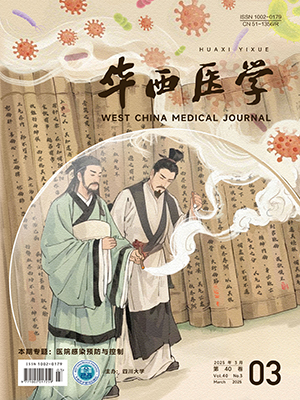| 1. |
Wu SM, Wu B, Liu M, et al. Stroke in China: advances and challenges in epidemiology, prevention, and management. Lancet Neurol, 2019, 18(4): 394-405.
|
| 2. |
Wang D, Liu J, Liu M, et al. Patterns of stroke between university hospitals and nonuniversity hospitals in Mainland China: prospective multicenter hospital-based registry study. World Neurosurg, 2017, 98: 258-265.
|
| 3. |
Wei JW, Arima H, Huang Y, et al. Variation in the frequency of intracerebral haemorrhage and ischaemic stroke in China: a national, multicentre, hospital register study. Cerebrovasc Dis, 2010, 29(4): 321-327.
|
| 4. |
Tatlisumak T, Cucchiara B, Kuroda S, et al. Nontraumatic intracerebral haemorrhage in young adults. Nat Rev Neurol, 2018, 14(4): 237-250.
|
| 5. |
Rådholm K, Arima H, Lindley RI, et al. Older age is a strong predictor for poor outcome in intracerebral haemorrhage: the INTERACT2 study. Age Ageing, 2015, 44(3): 422-427.
|
| 6. |
中华医学会神经病学分会, 中华医学会神经病学分会脑血管病学组. 中国脑出血诊治指南(2014). 中华神经科杂志, 2015, 48(6): 435-444.
|
| 7. |
Mancia G, Fagard R, Narkiewicz K, et al. 2013 ESH/ESC guidelines for the management of arterial hypertension the task force for the management ofarterial hypertension of the European Society of Hypertension (ESH) and of the European Society of Cardiology (ESC). Blood Press, 2013, 16(3): 135.
|
| 8. |
Weimar C, Kleine-Borgmann J. Epidemiology, prognosis and prevention of non-traumatic intracerebral hemorrhage. Curr Pharm Des, 2017, 23(15): 2193-2196.
|
| 9. |
Ariesen MJ, Claus SP, Rinkel GJ, et al. Risk factors for intracerebral hemorrhage in the general population: a systematic review. Stroke, 2003, 34(8): 2060-2065.
|
| 10. |
O’Donnell MJ, Xavier D, Liu L, et al. Risk factors for ischaemic and intracerebral haemorrhagic stroke in 22 countries (the INTERSTROKE study): a case-control study. Lancet, 2010, 376(9735): 112-123.
|
| 11. |
中国医师协会心血管病分会. 心血管疾病戒烟干预中国专家共识. 中华内科杂志, 2012, 51(2): 168-173.
|
| 12. |
van Drimmelen-Krabbe JJ, Bradley WG, Orgogozo JM, et al. The application of the International Statistical Classification of Diseases to neurology: ICD-10 NA. J Neurol Sci, 1998, 161(1): 2-9.
|
| 13. |
Qureshi AI, Tuhrim S, Broderick JP, et al. Spontaneous intracerebral hemorrhage. N Engl J Med, 2001, 344(19): 1450-1460.
|
| 14. |
Steiner T, Kaste M, Forsting M, et al. Recommendations for the management of intracranial haemorrhage - part I: spontaneous intracerebral haemorrhage. The European Stroke Initiative Writing Committee and the Writing Committee for the EUSI Executive Committee. Cerebrovasc Dis, 2006, 22(4): 294-316.
|
| 15. |
Van Asch CJ, Luitse MJ, Rinkel GJ, et al. Incidence, case fatality, and functional outcome of intracerebral haemorrhage over time, according to age, sex, and ethnic origin: a systematic review and meta-analysis. Lancet Neurol, 2010, 9(2): 167-176.
|
| 16. |
Koivunen RJ, Satopää J, Meretoja A, et al. Incidence, risk factors, etiology, severity and short-term outcome of non-traumatic intracerebral hemorrhage in young adults. Eur J Neurol, 2015, 22(1): 123-132.
|
| 17. |
Murata T, Takahashi T, Omori M, et al. Association of abnormal diurnal blood pressure variation with the development of silent cerebral infarction in patients with late-life-onset depression. Gen Hosp Psychiatry, 2003, 25(4): 298-300.
|
| 18. |
Knudsen KA, Rosand J, Karluk D, et al. Clinical diagnosis of cerebral amyloid angiopathy: validation of the Boston criteria. Neurology, 2001, 56(4): 537-539.
|
| 19. |
Forti P, Maioli F, Domenico Spampinato M, et al. The effect of age on characteristics and mortality of intracerebral hemorrhage in the oldest-old. Cerebrovasc Dis, 2016, 42(5/6): 485-492.
|
| 20. |
Gotoh S, Hata J, Ninomiya T, et al. Trends in the incidence and survival of intracerebral hemorrhage by its location in a Japanese community. Circ J, 2014, 78(2): 403-409.
|




